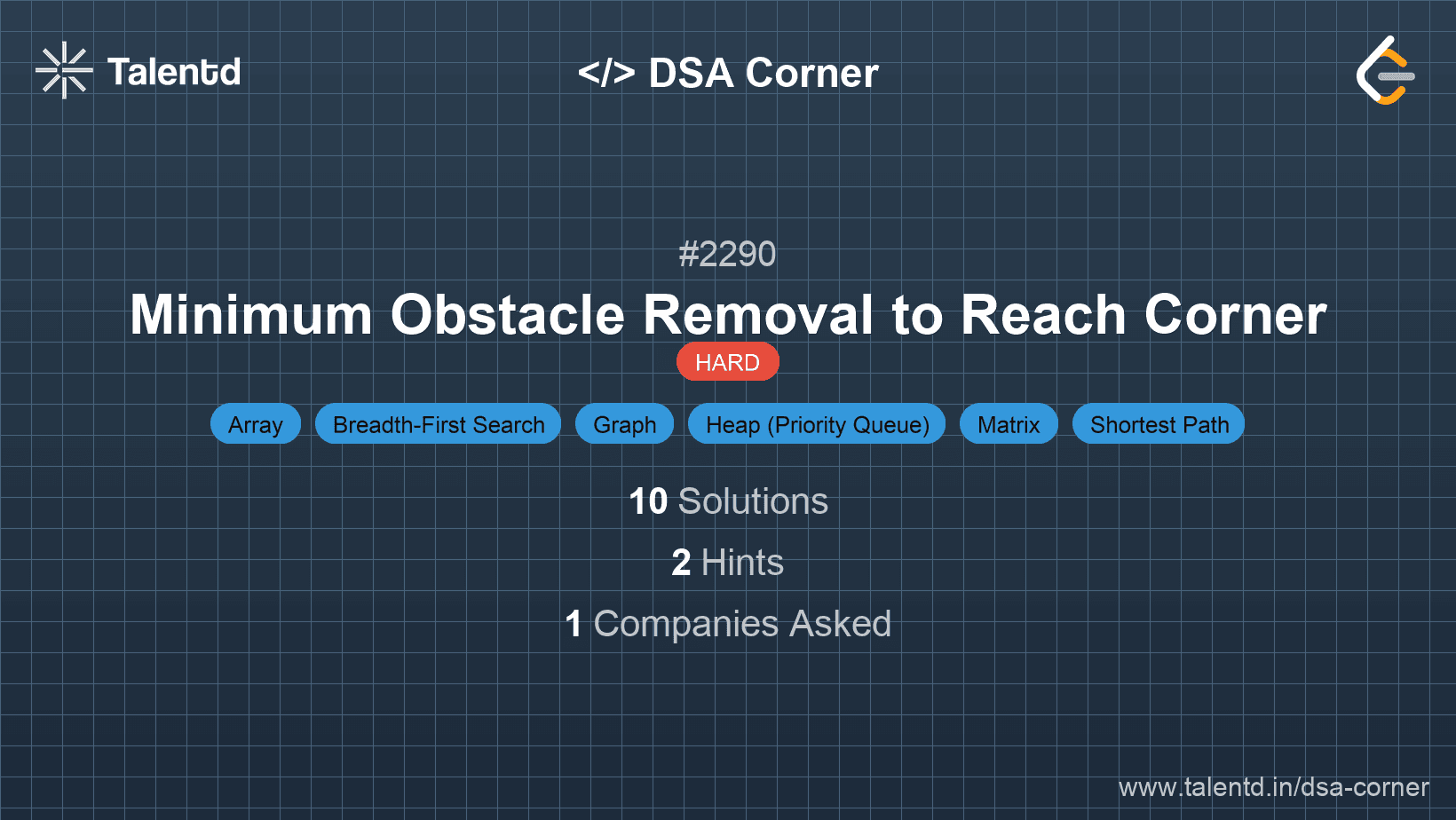
Sponsored
Sponsored
This approach uses a priority queue (or deque) to implement a modified Dijkstra's algorithm to explore the grid in a way similar to the 0-1 BFS (Breadth-First Search). Here, obstacles count as 'cost', and we try to find the minimum 'cost' path from the top-left corner to the bottom-right corner. We assign a priority based on the number of obstacles removed.
Time Complexity: O(m * n)
Space Complexity: O(m * n)
1import java.util.Deque;
2import java.util.LinkedList;
3
4class MinimumObstacles {
5 public int minimumObstacles(int[][] grid) {
6 int m = grid.length, n = grid[0].length;
7 int[][] dist = new int[m][n];
8 for (int[] row : dist)
9 Arrays.fill(row, Integer.MAX_VALUE);
10
11 Deque<int[]> deque = new LinkedList<>();
12 dist[0][0] = 0;
13 deque.offerFirst(new int[]{0, 0});
14
15 int[][] directions = {{0, 1}, {1, 0}, {0, -1}, {-1, 0}};
16
17 while (!deque.isEmpty()) {
18 int[] current = deque.poll();
19 int x = current[0], y = current[1];
20
21 for (int[] dir : directions) {
22 int nx = x + dir[0], ny = y + dir[1];
23 if (nx >= 0 && nx < m && ny >= 0 && ny < n) {
24 int cost = dist[x][y] + grid[nx][ny];
25 if (cost < dist[nx][ny]) {
26 dist[nx][ny] = cost;
27 if (grid[nx][ny] == 0) {
28 deque.offerFirst(new int[]{nx, ny});
29 } else {
30 deque.offerLast(new int[]{nx, ny});
31 }
32 }
33 }
34 }
35 }
36 return dist[m - 1][n - 1];
37 }
38}This Java solution applies a double-ended queue to simulate the priority queue behavior inspired by Dijkstra's shortest path algorithm. Each grid cell transition is examined to determine if it can be reached or bypassed, thus maintaining minimal obstacle removal count along traversed pathways and updating as required.
In this approach, we utilize dynamic programming combined with a monotonic queue to solve the problem of reaching the bottom-right corner with minimal obstacle removal. This alternative method involves leveraging the properties of dynamic arrays to store and update minimal removal costs dynamically while using a queue to maintain an effective processing order based on current state values.
Time Complexity: O(m * n)
Space Complexity: O(m * n)
1using System;
2using System.Collections.Generic;
public class MinimumObstaclesDP {
public int MinimumObstaclesDPMethod(int[][] grid) {
int m = grid.Length, n = grid[0].Length;
int[][] dp = new int[m][];
for (int i = 0; i < m; i++) {
dp[i] = new int[n];
Array.Fill(dp[i], int.MaxValue);
}
var deque = new LinkedList<(int, int)>();
dp[0][0] = 0;
deque.AddFirst((0, 0));
int[][] directions = { new[] {0, 1}, new[] {1, 0}, new[] {0, -1}, new[] {-1, 0} };
while (deque.Count > 0) {
var current = deque.First.Value;
deque.RemoveFirst();
int x = current.Item1, y = current.Item2;
foreach (var dir in directions) {
int nx = x + dir[0], ny = y + dir[1];
if (nx >= 0 && nx < m && ny >= 0 && ny < n) {
int cost = dp[x][y] + grid[nx][ny];
if (cost < dp[nx][ny]) {
dp[nx][ny] = cost;
if (grid[nx][ny] == 0) {
deque.AddFirst((nx, ny));
} else {
deque.AddLast((nx, ny));
}
}
}
}
}
return dp[m - 1][n - 1];
}
}This approach, implemented in C#, uses the dynamic programming paradigm, combined with a monotonic queue to steadily evaluate path efficiencies while making state transitions based on cumulative path attributes in a grid, thereby ensuring resultant optimal path calculations for the least disruptive path.